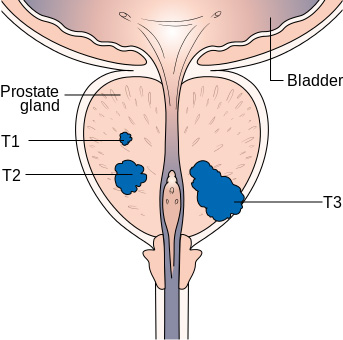

Diagram showing the T1-3 stages of prostate cancer. (Diagram courtesy of Cancer Research UK/Wikimedia Commons.)
By Mary Jane Dittmar
We are living in what probably is the most accelerated era of technology. No doubt, the proliferation of new findings has been greatly enhanced by the growing number of outlets for communicating “news” as it happens. It is especially gratifying to see that this technological evolution has been quite evident in the medical/health arena as well. To safeguard the health (and safety) component of our lives, it is important that we be HEALTH WARRIORS. We must acquire, evaluate, and apply knowledge; have a degree of control over our condition; be motivated to act; and be tenacious and able to view ourselves as “survivors” instead of as victims. Above all, we must believe that we can make the difference. Talking to your health care provider about a new approach you read about or taking part in a clinical trial you saw listed in your research might be just the “jolt” your protocol needs to bolster your system’s resources to move you a step nearer to improvement or a cure.
There is another aspect to the research we should keep in mind when we are matching wits with a disease like cancer: We need to prevent the mindset that causes us to place ourselves in the “established” statistical brackets cited in many reports. The new research tells us we are unique (persons with the same type of cancer respond differently); no human can tell us the day we will die; cancer is not a simple disease; it is multifaceted, and a person can have more than one type of cancer cell for a particular kind of cancer (this column addresses some of the newer approaches to prostate cancer). We have to remember that a treatment “unique” to us is more likely to be identified today than it was even 10 years ago. There are so many new ways to approach therapies for cancer in addition to the traditional methods, as is evident in the research findings noted below. Following are some results of recent prostate cancer-related studies.
A Guide to Prostate Cancer Treatment
Researchers at the Ontario Institute for Cancer Research, led by Principal Investigator John Bartlett, have developed diagnostic molecular markers that would guide physicians in treating prostate cancer patients. The project will involve 14 co-investigators (including pathologists, surgeons, oncologists, biostatisticians, and computational biologists) at institutions in several other provinces. The objectives of the proposed diagnostic tool are to identify patients whose prostate cancer will not become threatening over the patient’s lifetime and to determine if the newly developed molecular diagnostic test will more accurately predict which men are likely to develop aggressive cancer. The researchers believe that the tool will also help to create personalized treatments for early cancers. The diagnostic tool will be tested on a large group of men who had been diagnosed with prostate cancer. The research was funded by Prostate Cancer Canada with a grant from the Movember Foundation. http://bit.ly/1RnWwkH
New Treatments for Some Men with Metastatic Prostate Cancer?
Researchers are pursuing follow-up studies that could ultimately lead to additional treatment options for some men with metastatic castration-resistant prostate cancer (mCRPC). A finding in research co-led by Arul Chinnaiyan of the University of Michigan was that certain gene mutations were present in bone or soft tissue tumor biopsies of 150 men with mCRPC. Among the genes involved were BRCA2, BRCA1, and ATM, which were found to be more “enriched” in mCRPC samples than in primary prostate cancer. Researchers had previously observed the BRCA1 and BRCA2 mutations—generally associated with breast and ovary cancer risk—in prostate cancer, but at lower frequencies. Following are some findings/projections of this study on which future research can build and, hopefully, identify new and effective treatments for mCRPC patients.
- The gene alterations indicate that some mCRPC patients may benefit from therapies used to treat some breast and ovary cancer patients. Clinical trials will need to be conducted to confirm that.
- It might be beneficial for some patients with advanced prostate cancer to have some level of molecular profiling done so their treatment will be more specific to their condition. Researchers estimate that some 20 percent of men who have stopped responding to conventional hormone therapy may be candidates for this emerging class of drugs.
- Overall, 89 percent of the patients were found to have genetic anomalies that could be susceptible to drugs available on the market or being tested by drug companies.
- The findings provide additional evidence that genetic anomalies resulting in tumor growth can be common across several cancers, making it possible that a drug matched with a specific mutation may be effective against more than one malignancy.
These new findings are from an interim look at data from a study planned to sequence tumor DNA of 500 patients. Additional information is at http://bit.ly/1ExyVot and “Link Found Between Breast-Cancer Genes, Prostate Cancer” http://on.wsj.com/1F4ZZg5
You can also learn more at:
- http://emberly.fireengineering.com/topics/m/video/31250868/mike-dubron-interview.htm?q=prostate+cancer
- http://emberly.fireengineering.com/articles/fire_life/articles/2013/april/unexpected-meeting-brings-kuwaiti–texan-firefighters-together-d.html
- http://emberly.fireengineering.com/articles/fire_life/articles/2013/june/preplan-for-health-battles-as-for-firegound-battles.html
 Mary Jane Dittmar is senior associate editor of Fire Engineering and conference manager of FDIC. Before joining the magazine in January 1991, she served as editor of a trade magazine in the health/nutrition market and held various positions in the educational and medical advertising fields. She has a bachelor’s degree in English/journalism and a master’s degree in communications.
Mary Jane Dittmar is senior associate editor of Fire Engineering and conference manager of FDIC. Before joining the magazine in January 1991, she served as editor of a trade magazine in the health/nutrition market and held various positions in the educational and medical advertising fields. She has a bachelor’s degree in English/journalism and a master’s degree in communications.

